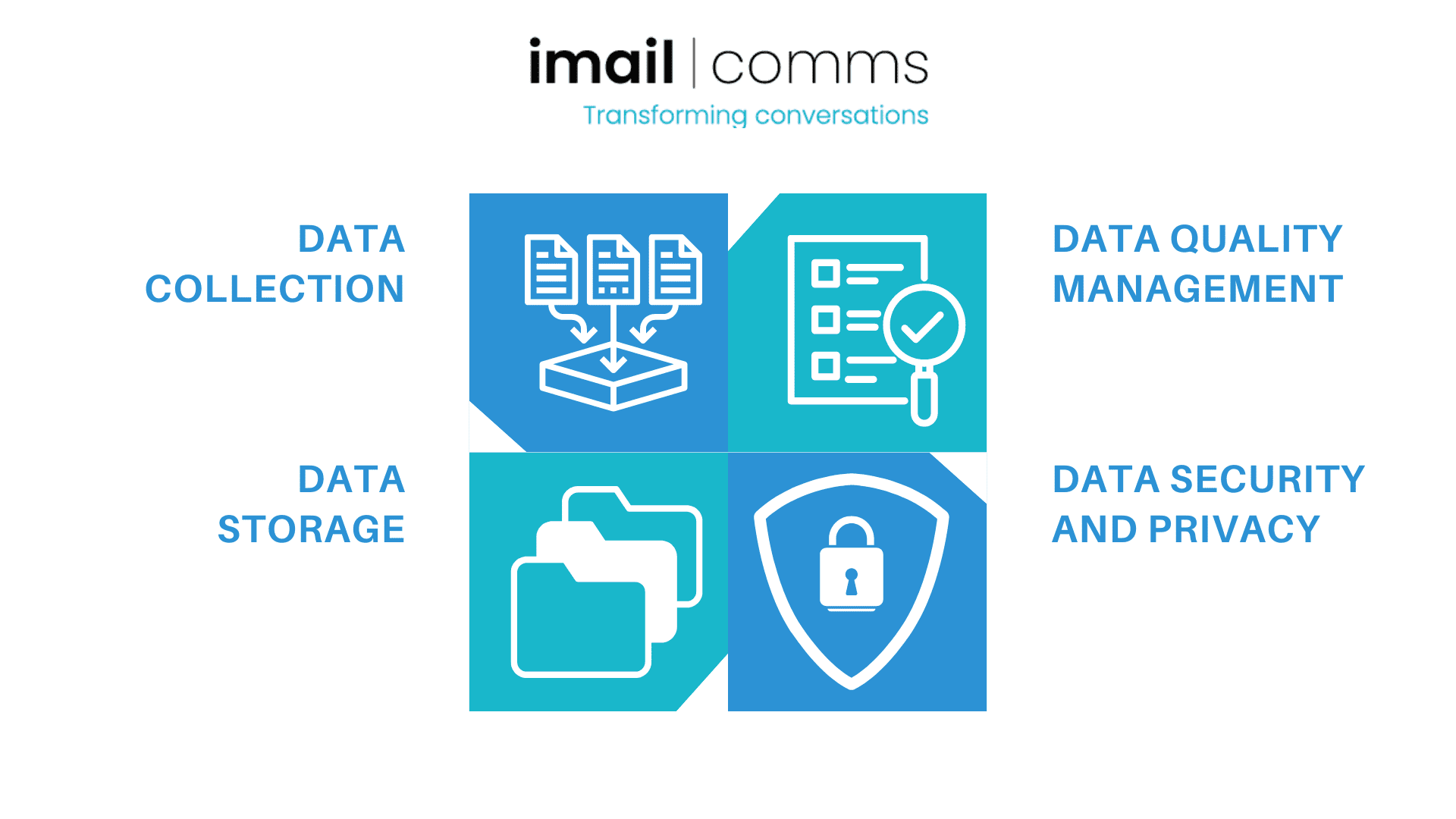Data reveals almost anything, and everything that data reveals, can be turned into strategies and actions that can redefine your business objectives and revolutionise your approach to realising them.
In this digital age, where every click, every view, and every purchase tell a story, data management has changed the narrative, becoming an indispensable asset of businesses that wish to thrive.
With imail comms, you are on the edge of exploring the world of Customer Data Management (CDM), where the relentless pursuit of understanding customer needs meets the precision of data-driven strategy.
But what exactly is CDM, and why is it turning heads in boardrooms across the globe?
Let’s find out the answers in this detailed imail comms guide that will act as your compass, helping you to plot a course through the complexities of collecting, managing, and analysing customer data.
Breaking Down Data Silos
Data silos occur when data is isolated within departments or systems, making it inaccessible to other parts of the business that might need it. This not only stifles collaboration but also clouds the overall view of customer interactions and behaviours.
Imagine each department in your company is like a separate library in a vast city of information. If each library keeps its books to itself, the knowledge within is constrained to the few who have access. Similarly, when data silos occur, the insights it can provide are restricted to specific teams, which can lead to an inconsistent customer journey and missed opportunities for cross-functional innovation.
CDM breaks down the barriers that data silos create, offering you a unified view of customer data that is invaluable for making informed decisions. How?
- Unified Customer Data: By unifying data, CDM ensures that every team, from sales and marketing teams to customer service representatives, works with the same comprehensive view of your customer. This unity is critical for delivering a consistent customer experience across all data touchpoints.
- Improved Data Utilisation: When data is liberated from silos, the speed and accuracy of your data-driven decisions improve. With lesser data decay, teams can rapidly access and act on insights, whether to address emerging market trends or to personalise customer communications.
- Enhanced Innovation: With a holistic view of data, you can more easily identify patterns and opportunities that would be obscured in a siloed system. This panoramic perspective propels innovation, as teams are equipped to develop new products, services, and are capable of implementing CDM processes that are finely tuned to the evolving desires of individual customers.
Understanding Customer Data Management (CDM)
Customer data management refers to the practices, technologies, and strategies that businesses use to collect, store, protect, and analyse customer information.
At its core, customer data management platform aims to create an all-inclusive customer database that is accessible, secure, and usable across various business operations. Whether you’re tailoring marketing campaigns, improving customer service, or enhancing product development, effective CDM provides a 360-degree view of your customer.
CDM is not simply about gathering more customer data. It’s about making raw data meaningful and actionable, transforming it into a strategic asset. From seeing a data point as a by-product of your business activities, you can now view customer data as a critical asset that informs your strategic decision-making and operational efficiency.
The Components of Effective Customer Data Management
Grasping the essentials of customer data management (CDM) requires a keen understanding of its fundamental components. Each segment of CDM, from the initial data gathering to the protection of data, plays a critical role in creating a strategic approach that not only secures your data but also makes it actionable.
Let’s explore these key elements.
Data Collection
Data collection forms the foundation of customer data management strategy.
The methods and tools used to collect data define the volume and variety of information that can be processed and analysed. Typically, a business benefits from utilising a mix of techniques for collecting data, such as customer feedback forms, online behaviour tracking through analytics platforms, and recording transaction details at points of sale.
Emerging technologies, like customer data platforms, simplify customer data collection and consolidation from diverse data sources, providing a more complete picture of your customer interactions and customer relationship management.
Quick Overview
Critical data collection can take place from one or more of the following data sources:
First-Party Data: Data points collected directly from your customers, which provides the most valuable insights.
Second-Party Data: Data shared with various co-partners, which is less accurate.
Third-Party Data: Data points attained from unknown sources or organisations that do not have direct interaction with your business or customers.
Data Storage
After collecting data, all the information you now have at your disposal must be stored, and your choice of storage solutions can significantly impact the accessibility and usability of the data.
Let’s take a look at some of the options that can act as your data warehouses.
- Cloud Storage: Many companies opt for cloud solutions due to their scalability and flexibility. Cloud storage allows data to be accessed from anywhere, making it ideal for businesses that operate over multiple locations or have remote teams.
- On-Premises Storage: Some businesses prefer on-premises solutions for their data control and security benefits. This method involves storing data on local servers, which can be more secure but also requires more maintenance and upfront investment.
- Hybrid Storage: Combining both cloud and on-premises storage, hybrid solutions offer balance between scalability and control, allowing businesses to manage sensitive data on-premises while leveraging the cloud for less critical information.
Data Quality Management
High-quality data is the backbone of effective decision-making and strategic planning. Managing customer data through techniques like regular audits, validation processes, and data cleansing routines can aid you in ensuring data quality maintaining its integrity.
Data quality management also helps in identifying and eliminating duplicate data, which can skew analytics and lead you to make poor business decisions.
Data Security and Privacy
Protecting your customer data from breaches and leaks is paramount for establishing and maintaining trust with your client base, and your company should always have a data governance strategy in place.
A data governance strategy involves implementing advanced security measures like encryption, access controls, and regular security audits. Additionally, training your employees on security protocols is critical, as human error is a common vulnerability in data breach.
According to a motive.co survey, 67% of UK online users have admitted to leaving a website due to concerns about how their data might be used. This means that if you’re trading online, you could be losing nearly two-thirds of your customers if you’re not adequately respecting their online privacy,
Your data governance strategy also contributes to the strength and effectiveness of your customer data management systems, ensuring that data regulations are constantly complied with.

Establishing a Customer Data Management Strategy
To master data management strategy-development, always think of data as your strategic operational catalyst.
In this digital expedition, data isn’t just numbers and charts; it’s the voice of your customers, whispering valuable insights into your ear.
This section will dissect the process of developing a detailed customer data management framework, integrating it effectively with your current systems, and ensuring it adheres strictly to UK data governance laws.
Formulating a CDM Blueprint
Creating an effective CDM strategy involves methodical planning and foresight.
Here’s how you can lay a solid foundation:
- Evaluate Current Data Resources: Begin by reviewing the data you currently handle, specifically first-party customer data. Assess the origin and applications of each data point and determine its relevance to different areas of your business.
- Set Clear Goals: Pin down precise goals for your CDM efforts, such as enhancing client interactions, boosting marketing precision, or bolstering critical data security.
- Engage Key Players: Identify and involve individuals across your organisation who will interact with or benefit from enriched customer data. This collaborative approach helps align the strategy with overarching business objectives.
“The goal is to turn data into information, and information into insight”.
— Carly Fiorina, Former Executive, President, and Chair of Hewlett-Packard Co
Harmonising CDM Strategy with Existing Infrastructure
Integrating a CDM strategy into your existing business systems doesn’t have to be a Herculean task.
Here are techniques to ensure smooth customer data integration:
- Audit Existing Systems: Map out all current business systems that handle data and identify potential integration points or bottlenecks.
- Adopt Middleware Solutions: Use middleware to facilitate communication between new data management tools and existing applications without the need for extensive modifications. Middleware is software that connects different applications or systems, enabling them to communicate and share data efficiently.
- Continuous Testing and Feedback: Implement iterative testing and allow for feedback from users to fine-tune the integration process.
Adherence to Data Governance and Compliance
In the UK, ensuring data governance and compliance involves a thorough understanding of collected data privacy regulations.
Here’s how you can ensure compliance:
- Data Protection Officer: Appoint a Data Protection Officer (DPO) to oversee compliance with GDPR and other relevant data privacy laws such as the Data Protection Act 2018.
- Regular Audits: Conduct regular audits of data processes to ensure they meet legal standards and address any identified gaps.
- Staff Training: Regularly train staff on their responsibilities under data protection laws and the importance of compliance in their daily roles.
The Business Outcome of Customer Data Management
It is evident that a customer data management platform transcends traditional data handling, revolutionising customer experiences to supercharging your marketing efforts.
This section explores the tangible impacts that effective CDM can have on your business.
Substantial Business Growth
Data is information, and information is power. This is how customer data management strategy has a direct impact on the growth and success of your business, as CDM advances the upcoming aspects of your business.
Operational Efficiency
- Automation and Integration: Enhances data collection and analysis, reducing manual efforts and minimising errors.
- Cost Reduction: Lowers operational costs by optimising processes and enhancing workflow efficiency.
- Strategic Focus: Frees up resources, allowing teams to concentrate on strategic, value-added activities.
Revenue Growth
- Targeted Marketing: Utilises detailed customer insights to implement personalised marketing campaigns that directly address customer preferences and increase engagement.
- Product Development: Customer interaction data helps you develop new products and services that meet the evolving needs of the market.
- Upselling and Cross-Selling: Employs data-driven strategies to identify opportunities for upselling and cross-selling, boosting sales and customer lifetime value.
Enhancing Customer Experience
An impactful customer data management strategy transforms customer data into unified customer profiles with valuable insights, which enhances interactions and guarantees customer retention.
Let’s illustrate how sophisticated data management leads to a superior customer experience:
- Personalisation at ScaleImagine being able to offer every customer a tailor-made experience that feels both personal and relevant. CDM systems analyse vast amounts of data to predict customer preferences and behaviours, allowing you to tailor your offerings and communications in real-time.This personal touch not only boosts customer satisfaction but also increases loyalty for your brand.
- Responsive Customer ServiceWith CDM, you have immediate access to detailed profiles of existing customers, including past interactions, preferences, and feedback. This information must always be assembled and recorded by a customer service team from various data sources.This information enables your customer service representative to provide informed and quick resolutions to inquiries, enhancing overall customer satisfaction.
- Smooth User JourneysBy tracking and analysing how individual customers interact with different touchpoints, you can identify bottlenecks and enhance processes. Whether it’s simplifying an online purchase process or optimising navigation through a mobile app, CDM helps ensure that every step of the customer journey is as smooth and enjoyable as possible.
Boosting Marketing Efforts
Incorporating a customer data platform into your business can significantly amplify the effectiveness of marketing strategies by ensuring that the right messages reach the right audience at the right time. Here’s How:
- Targeted Marketing Campaigns: Data-driven insights allow marketing teams to identify specific customer segments and tailor their campaigns to speak directly to their unique needs and desires.
- Predictive Analytics: Utilising predictive models, you can forecast future buying behaviours, product preferences, and potential upsell opportunities. This foresight enables proactive campaign planning and a strategic market approach, keeping you one step ahead of customer expectations and competitor moves.
- Improved ROI: By understanding which channels and tactics drive the best outcomes, you can allocate their budgets more effectively, focusing on high-performing strategies that maximise your return on investment.
Tools and Technologies in CDM Strategy
The UK.GOV Business Data 2022 survey report indicates a strong move towards digitalisation. The survey revealed that 85% of businesses now handle digital data, with virtually all companies employing 10 or more staff fully embracing digital data management.
With this vast amount of data entrusted to your business, help becomes a necessity. Not to mention that to maximise the potential of your customer data management, precision should meet strategy and technology is the key.
This section glances at the revolutionary tools that are reshaping how you can interact with your most valuable asset: customer data.
Advanced Analytics and Machine Learning
The integration of Artificial Intelligence (AI) and Machine Learning (ML) is transforming customer data management, making it possible to anticipate your customer needs, personalise your communications, and respond to market fluctuations swiftly.
Impact of AI and ML includes:
- Predictive Customer Behaviour: AI models predict future behaviours, enabling proactive customer engagement.
- Smarter Decision-Making: Machine learning algorithms sift through data, identifying trends and making data-driven recommendations.
- Efficiency in Operations: Automate routine tasks, such as data entry and analysis, enhancing productivity and reducing errors.
Upgrading Customer Data Management with Automation
Automation is key in refining the efficiency and accuracy of your customer data management processes. It ensures data consistency and facilitates quicker access to critical information, supporting your timely business decisions.
Benefits of Automation in CDM:
- Efficient Data Handling: Automates the integration and cleansing of data, ensuring high data quality.
- Accessibility and Timeliness: Provides stakeholders with real-time, updated data, imperative for operational agility.
- Cost Reduction: Minimises manual labour by automating repetitive tasks, allowing teams to allocate resources to strategic areas.
A Customer Data Platform is essential in managing the vast amount of information your company collects through automation. By centralising customer data into a single repository, a customer data platform enables a coherent, comprehensive view of your customer information, which is necessary for creating targeted marketing strategies and enhancing interactions with your customers.
![]()
Lenovo surveyed 600 senior executives from companies generating at least $500 million in revenue across five countries. Their Data for Humanity study was published, and it was paradigm-shifting.
The research examined how major global businesses are utilising data, and subsequently identified opportunities where these businesses can use this information to propel genuine and measureable growth. The research also revealed that only 15% of the surveyed sample are data leaders, 78% of which have drastically increased their revenue in the past 12 months.
It’s time for you to become a data leader.
Like we’ve been trying to convey, data reveals everything, so look at the data in front of you. Customer data management yields outcomes that reflect genuine growth. With imail 2.0, imail comms is changing the conversation and helping you achieve actual results. With its innovative and enhanced data integration capabilities, imail 2.0 will move you closer to becoming the data leader that will ultimately lead the market.
Frequently Asked Questions (FAQ’s)
Let’s address other queries you may have when it comes to customer data management.
What is data decay, and why does it happen?
Data decay refers to the degradation in the quality of data over time. It may occur due to changes in customer information, outdated business contacts, or erroneous data entries. Regular updates and data cleansing practices are essential to mitigate data decay.
How does third-party data complement first-party customer data?
Third-party data provides additional insights that first-party data may not cover, such as broader market trends and customer behaviours outside of direct interactions with your business.
How can a customer data platform handle data privacy concern?
Customer Data Platforms handle data privacy by incorporating features such as data anonymisation, consent management, and secure data storage to comply with regulations like GDPR. They also support data access and deletion requests to uphold user privacy rights.






Leave A Comment
You must be logged in to post a comment.